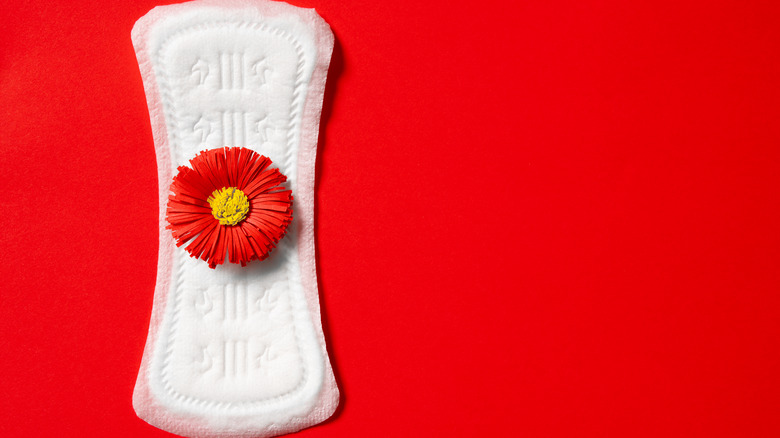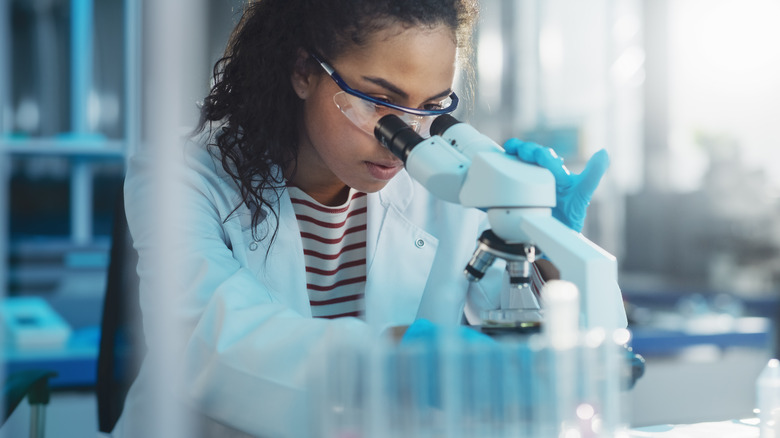Why Health Experts Want To Destigmatize Menstrual Blood
Examining the history of medicine is a rather eyebrow-raising experience, particularly in regard to how women's bodies have long been perceived. While the great minds of ancient Greece made extraordinary advances, they struggled to understand the female anatomy, often describing women's genitals as "lesser" versions of male genitals, labeling women's reproductive organs as testes and believing they, too, had sperm (per Stanford University).
Jonny Thomson, philosophy professor at Oxford University, detailed on the Big Think how Aristotle believed that in the creation of life, man's sperm provided everything the child needed to be human and the woman simply provided space for it to grow. From this, Aristotle deduced that any problem with the child was the result of the woman's inferior womb.
Perhaps the most nefarious statement accredited to him was that women were "mutilated males" and that a child born female was incomplete. This kind of thinking gave way to the theory of the wandering womb — the idea that the womb was a creature of sorts — separate from the woman, that could move through the body causing a multitude of ailments, including the infamous hysteria (per Big Think).
A study published in Women, Gender, History credits Plato with suggesting hysteria was a result of a woman's sterility, feeding the perspective that her sole purpose is reproduction. This lack of understanding gave way to the widespread circulation of misinformation that carried with it a detrimental narrative and dangerous repercussions affecting women for many years to come.
Modern day science
It's clear that we've come a long way since then, yet many in the medical community make the argument that the female anatomy is still grossly understudied in comparison to its male counterpart. In an interview with the National Library of Medicine, Dr. Allison Hill-Edgar says that even today, medical textbooks are chock-full of gender bias. She notes that studies have indicated that only 11% of the pictures in anatomical textbooks are of female bodies and that most skeletal models and CPR manikins take the male form. All of these seemingly minor discrepancies, she points out, can have a profound effect on the attitude medical students have surrounding gender.
A 2014 study published in PLOS Biology found that in recent years, the number of studies examining genitalia has significantly increased, and that these studies reveal a considerable male bias that has continued to increase since 2000. Through their research, they deduced that this male bias persists — despite its presence being well known — not because a woman's body is shrouded in mystery, but rather because of the long withstanding narrative that males have a dominant role when it comes to sex, and that women's anatomy is fixed and unchanging.
How period blood can help
Most women can attest to the fact that woven into our society is this bizarre, sort-of-unspoken shame surrounding our periods, and so too is a bit of that shame instilled in all of us. But what if the gap in wholly understanding the female reproductive system lies in our period blood? Christine N. Metz, a professor at the Institute of Molecular Medicine at the Feinstein Institutes for Medical Research at Northwell Health, argues in an article for Scientific American that it does.
Metz notes that by studying menstrual blood, research teams like hers are able to collect data on infertility, infections like the human papillomavirus and chronic endometritis, uterine cancer, painful periods, and perimenopausal changes, all without subjecting women to invasive surgeries. In fact, thanks to a study currently being conducted, she is using information gathered from menstrual blood to learn how to develop a non-invasive, early diagnostic test for women who may be suffering from endometriosis. (Can you say "Superwoman"?)
Metz stresses that for the sake of scientific progress, it is crucial that we shed the stigma that period blood is a dirty little secret meant only for the trash, and hold it up as a vital ingredient in the study of women's health.



